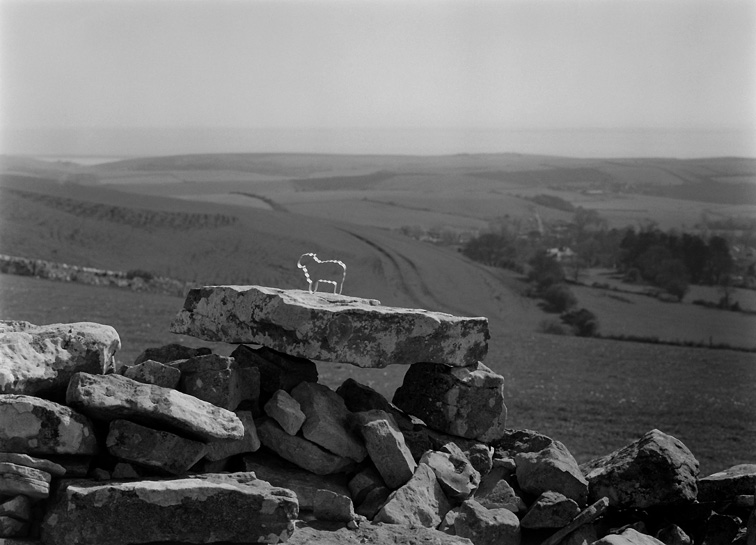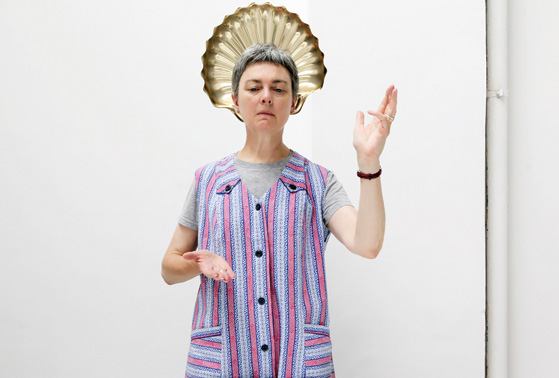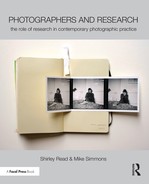Sian Bonnell: Lessons from the Audience
The responses of audiences over the years have had quite a profound impact on how I have developed my work and on at least two occasions this response has led to a major re-think on my part. Despite the knowledge that a viewer may be triggered into a different reading of the image than was intended, I had not been prepared for these readings to affect some form of change in my own interpretation and communication of the work.
My photographs have the appearance of absurdity and are conjured from the most banal of experiences and objects. The methodology that I have developed over 30 years is one that is open-ended, experimental and exploratory. I will work with whatever is there to hand and wherever I am—I do not need a studio in order to make my work. I tend also not to follow technical prescriptions—not because the proper tool or implement is unavailable, but because I want to see what it will do in a different usage or context or what it’s not supposed to do. My approach to my work revolves around lived experience and stems from my education, studying the art movements that influenced me most, Dada and Arte Povera; and this approach is woven through my everyday life—I will make a piece of work just out of my lunch.
My early work centred on landscape and object; I used juxtaposition as a method to explore the flora and fauna of the local land and noticed that in re-placing disparate objects, toys and food into alien territory the objects began interrogating themselves and their dislocations, producing a variety of atmospheres that were sinister and frightening. I was examining every facet of the landscape genre with particular emphasis on politics; land use, territory, ecology, sustainability and gender. I was utterly earnest in my approach but although the methods I used to make these images were quite absurd (running up and down hills with set jellies in moulds, slapping these down on the land and photographing them) it never occurred to me that the humour might leach into the images themselves.
I was deadly serious. The photographs were hysterically funny. In exhibitions people were laughing uncontrollably. I was mortified and deeply upset; I interpreted this as a huge failure. It took a little while but through a reflective process I realised that this reaction could be turned on its head and be used positively. After all, humour can be seen as a gift and one that can be used to hold an audience’s attention as well as to draw them in. This was when I realised that listening to the audience’s response, though perhaps bruising, can have the power to affect change.

From the series Groundings.
© Sian Bonnell
The audience for that early work gave me permission to be myself as a maker. Since then I have not been ashamed of my methods and ideas. I realise that perhaps looking stupid or absurd in the making of an image is a small price to pay for communicating complex ideas. I realise, too, that audiences are far more intelligent and intrepid than we presume and are prepared to go a very long way with what is being asked of them, if it is done with evident integrity.
The second time that audiences profoundly affected my work was in 2011 when I was showing a preview of some of the work I had made on a three-month fellowship in Rome. Camera: How to be Holy featured self-images enacting religious gestures and Camera: Stigmata depicted the re-enactment of five versions of St Catherine of Sienna receiving the stigmata. I was concerned with notions of superstition and religion and how these still might have relevance today. This stemmed from my mother’s desire for my sister and me to be indoctrinated into the Roman Catholic faith as small children, despite our being a Protestant family. As a child I had become obsessed with the idea of holiness and, for a seven-year-old, this involved the acquisition of a halo.
Being a grown-up meant that I could revisit this early fascination and this led me to fashion rough halos out of domestic disposable plates and party servers. I also acquired three housecoats from a street market. These were unflattering, highly patterned garments, the kind worn by older ladies to do their housework. I began making self-images wearing this clothing and the halos. This led to my researching the gestures found in religious iconography of all kinds; not just in High Renaissance painting but in the cheap tat sold at the Vatican. I made a series of images reiterating these gestures under the title How to be Holy. The concept was one of instruction, like a manual or like a TV programme that shows you how to do something: ‘Here’s one I made earlier.’

From the series Camera I: How to be Holy, 2011
© Sian Bonnell
I used available light in the studio, I sourced a costume that alluded to the housewife or a cleaning lady—but of course she would not be doing what I was doing whilst wearing it. My halos were made from picnic ware. Sometimes I was the Virgin, sometimes a priest, sometimes an angel; I was being both male and female.
I introduced my dressing gown (a hooded grey velour robe zipped up the front), with a selection of homemade paper and card halos for Camera: Stigmata. As in the previous set of pictures, I made no attempt to hide my status as a twenty-first-century woman.
At the exhibition when they were shown I was shocked by the reaction of the audience. Men and women were affected equally; they would start with laughter and then suddenly they would be overcome emotionally, many cried. I had not expected this and it gave me a jolt, in that I had underestimated the power that photographs can have to play with a spectator’s emotion. This intense reaction of the viewers threw me. I put the work aside for two years, which allowed a retrospective view of my practice over a 30-year period. I was unable to let the work go until I had undergone this review.

From the series Camera II: Stigmata, 2011.
© Sian Bonnell
Normally, once my work has been exhibited, I must let it go. It no longer belongs to me—it is out in the world and has to fend for itself. I continue to learn a great deal from the reactions and views of audiences and from the different readings the work provokes for them, especially if new contexts for the work are evoked in that process. I find this intensely exciting and rewarding; I respect completely what audiences have to teach me.
